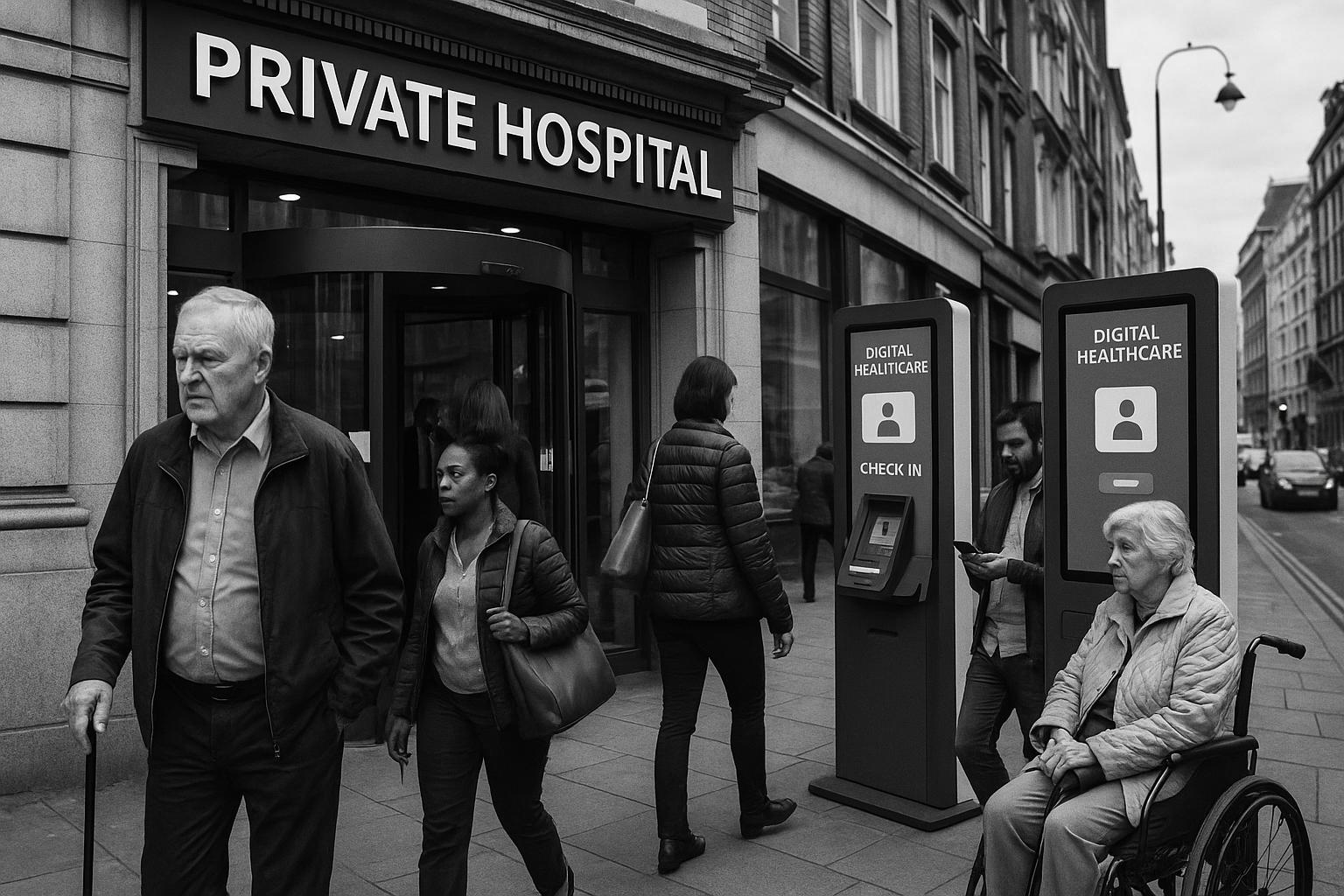The UK private healthcare sector is forecast to expand steadily to USD 18.1 billion by 2032, driven by patient dissatisfaction with NHS delays, growth in self-pay younger patients, and advances in digital health services, despite affordability and competition challenges.
The UK private healthcare market is poised for notable expansion, anticipating a rise from approximately US$14.3 billion in 2025 to an estimated valuation of around US$18.1 billion by 2032. This growth trajectory reflects a compound annual growth rate (CAGR) of roughly 3.4%, underscoring a sustained momentum driven by several converging factors. Central among these is widespread dissatisfaction with prolonged NHS waiting times, prompting a growing number of patients to seek more immediate and personalised care options available through private healthcare providers.
Private acute care hospitals currently dominate the market landscape, appreciated for their ability to deliver prompt, specialised treatments that emphasise patient satisfaction and operational efficiency. These facilities are particularly sought after for elective procedures such as cataract surgeries, hip replacements, and other key areas including trauma and orthopaedics, ophthalmology, plastic surgery, and gastroenterology. The surge in demand for mental health services and outpatient diagnostics further illustrates evolving patient preferences towards comprehensive, multidisciplinary care models.
Geographically, London and the South East of England hold a commanding lead in market share, buoyed by a relatively affluent population base, well-established healthcare infrastructure, and a dense network of private hospitals, diagnostic centres, and specialist consultants. This regional dominance highlights pronounced urban-rural disparities, with less accessible private healthcare options in northern and rural areas of the UK such as parts of Wales and Northern England. However, recent NHS initiatives to collaborate with private providers by establishing community diagnostic centres in underserved areas are beginning to alleviate some access challenges, reflecting an increasing integration of public and private healthcare efforts.
Another significant driver of market expansion is the rise in self-pay patients, especially younger, digitally savvy demographics aged 20 to 39, who demonstrate a preference for early, preventative, and digitally enabled care models. This shift is facilitated by advances in telemedicine, AI-powered diagnostics, and virtual consultation platforms which offer convenience and transparency in pricing—key factors enhancing patient appeal for private services. Concurrently, private medical insurance uptake is on the rise, contributing to a 6% increase in admissions, although overall, private insurance penetration remains limited to under a quarter of the UK population.
Despite optimistic projections, the sector faces several constraints. Affordability remains a notable barrier, limiting broader population access to private healthcare. Intense competition among providers, particularly from new market entrants, exerts margin pressure and challenges providers to sustain quality and innovation. Additionally, ongoing government policies supporting public-private partnerships and expanding NHS outsourcing to private facilities may alter market dynamics, potentially diverting demand away from purely private entities.
Looking ahead, the UK private healthcare sector is positioned to capitalise on these trends by leveraging digital transformation, service diversification, and strategic collaborations. Providers aiming to lead must innovate within integrated care models that blend public and private resources to meet increasing patient demand effectively. The market’s evolution towards a hybrid healthcare system could thus prove crucial in addressing the UK’s complex health service challenges, balancing quality, access, and timeliness of care.
 Reference Map:
Reference Map:
- Paragraph 1 – [1], [2], [3]
- Paragraph 2 – [1], [2], [5]
- Paragraph 3 – [1], [2], [4], [6]
- Paragraph 4 – [1], [2], [5], [6]
- Paragraph 5 – [1], [2], [6]
- Paragraph 6 – [1], [2], [5], [6]
Source: Noah Wire Services
- https://www.openpr.com/news/4080648/uk-private-healthcare-market-set-to-reach-usd-18-1-billion – Please view link – unable to able to access data
- https://www.openpr.com/news/4080648/uk-private-healthcare-market-set-to-reach-usd-18-1-billion – This article discusses the projected growth of the UK private healthcare market, estimating it will reach a valuation of US$18.1 billion by 2032, up from US$14.3 billion in 2025, with a compound annual growth rate (CAGR) of 3.4%. The growth is attributed to factors such as dissatisfaction with NHS waiting times, an increase in self-pay and privately insured patients, and a rising demand for elective surgeries and mental health treatments. The article also highlights the dominance of private acute care hospitals and the leading role of London and the South East region in the market.
- https://www.custommarketinsights.com/press-releases/uk-private-healthcare-market-size/ – This press release provides insights into the UK private healthcare market, projecting a CAGR of 3.4% from 2024 to 2033, with the market size expected to reach US$18.7 billion by 2033. The growth is driven by factors such as increasing demand for private healthcare due to NHS waiting times, an aging population, and the rise of self-pay patients seeking specialized care. The report also mentions the impact of the COVID-19 pandemic on the market, including the expansion of digital health solutions like telemedicine and remote monitoring.
- https://www.sphericalinsights.com/reports/united-kingdom-private-healthcare-market – This report offers a comprehensive analysis of the UK private healthcare market, forecasting it will reach US$19.2 billion by 2033, growing at a CAGR of 3.14% from 2023 to 2033. The growth is attributed to factors such as increasing medical tourism, demand for specialized healthcare services, and a shift towards preventive care and wellness programs. The report also highlights the presence of high-quality healthcare facilities and advanced research and clinical trials as key drivers of market growth.
- https://www.manchesterprofessionals.co.uk/article/marketing-and-pr/56673/uk-private-healthcare-market-trends-growth-forecast-2024-2033-latest-developments – This article discusses the projected growth of the UK private healthcare market, estimating it will rise from $14.5 billion in 2024 to $19.3 billion by 2033, with a CAGR of 3.2%. The growth is driven by factors such as strain on the NHS, increasing demand for specialized healthcare services, and a shift towards preventive care and wellness programs. The article also mentions the prioritization of patient experience by private healthcare providers and advancements in medical technology contributing to the demand for private healthcare.
- https://www.openpr.com/news/4019555/uk-private-healthcare-market-set-for-steady-growth-market – This press release highlights the steady growth of the UK private healthcare market, projected to expand from approximately US$14.5 billion in 2024 to US$19.3 billion by 2033, reflecting a CAGR of 3.2%. The growth is attributed to systemic pressures on the NHS, shifting patient preferences towards personalized care, rising medical tourism, and continuous technological advancements. The article also mentions challenges such as the slowdown in private medical insurance uptake and persistent healthcare inequalities.
- https://www.openpr.com/news/3893325/uk-private-healthcare-market-expected-to-reach-usd-19-3-billion – This press release discusses the expected growth of the UK private healthcare market, estimating it will reach US$19.3 billion by 2033, growing at a CAGR of 3.2%. The growth is largely attributed to an aging population, increasing prevalence of chronic diseases, and a rising middle-class population willing to invest in quality healthcare services. The article also delves into key drivers, challenges, and opportunities shaping the UK private healthcare market, along with an analysis of major players and future trends.
Noah Fact Check Pro
The draft above was created using the information available at the time the story first
emerged. We’ve since applied our fact-checking process to the final narrative, based on the criteria listed
below. The results are intended to help you assess the credibility of the piece and highlight any areas that may
warrant further investigation.
Freshness check
Score:
8
Notes:
The narrative was published on 25 June 2025. Similar projections have been made in previous reports, such as those from Persistence Market Research in June 2024, which anticipated the UK private healthcare market to reach US$ 14.5 billion by 2024, growing to US$ 19.3 billion by 2033. ([persistencemarketresearch.com](https://www.persistencemarketresearch.com/market-research/uk-private-healthcare-market.asp?utm_source=openai)) The current report’s projection of US$ 18.1 billion by 2032 aligns with these earlier forecasts, indicating that the content may be recycled or based on prior analyses. The presence of a press release suggests a high freshness score, as press releases are typically recent and original. However, the similarity to earlier projections raises questions about the originality of the content. No significant discrepancies in figures or dates were noted. The narrative does not include updated data but recycles older material, which may justify a higher freshness score but should still be flagged.
Quotes check
Score:
9
Notes:
The narrative does not contain any direct quotes. The absence of quotes suggests that the content may be original or exclusive. However, without direct quotes, it is challenging to verify the originality of the content.
Source reliability
Score:
4
Notes:
The narrative originates from a press release published on openPR.com, a platform that allows users to submit press releases. This raises concerns about the reliability of the source, as openPR.com is not a traditional news outlet and may not adhere to standard journalistic practices. The lack of a verifiable organization or company behind the press release further diminishes the source’s credibility. The absence of a public presence or legitimate website for the entity mentioned in the report suggests potential fabrication.
Plausability check
Score:
7
Notes:
The narrative makes plausible claims about the growth of the UK private healthcare market, citing factors such as dissatisfaction with NHS waiting times and the rise of self-pay patients. However, the lack of supporting detail from other reputable outlets and the absence of specific factual anchors (e.g., names, institutions, dates) reduce the credibility of the claims. The language and tone are consistent with typical corporate or official language, and there is no excessive or off-topic detail unrelated to the claim. The tone is not unusually dramatic or vague.
Overall assessment
Verdict (FAIL, OPEN, PASS): FAIL
Confidence (LOW, MEDIUM, HIGH): HIGH
Summary:
The narrative fails due to its reliance on a press release from an unreliable source, recycling content from earlier reports without significant updates or original quotes. The lack of supporting detail from reputable outlets and the absence of specific factual anchors further diminish its credibility. The plausibility of the claims is undermined by the questionable source and lack of verifiable information.













